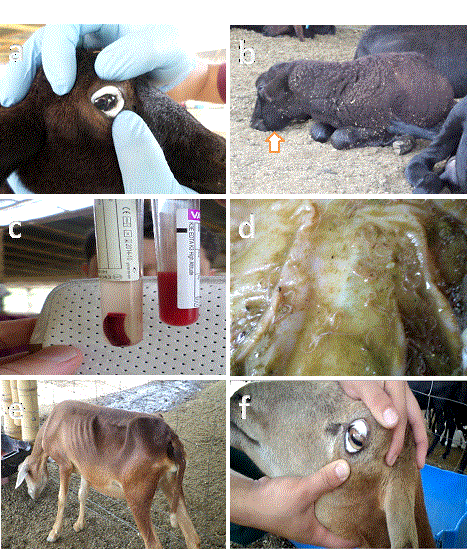David Villar’s Updates
Case of mortality in lambs from a Colombian flock
Case of mortality in lambs from a Colombian flock
Signalment
500 flock, cross-bred sheep, farm established 5 years ago with animals purchased from different locations. No vaccines ever used (not available in the country). Deworming has been done as a “blanket treatment to all animals” on a monthly basis with inyectable levamisole, ivermectin and albendazole. Same farm has 40 beef creole cattle in different pastures never shared with sheep.
History
A total of 13 lambs between ages of 3 to 6 months died in August 2014, and according to the herdsman, with similar histories of eyelid paleness, bottle jaw, anorexia and severe weakness preceding death, or the animals were just found dead. He states that many newborns tend to be very small, weak, have high mortality and require bottle feeding because the dam is not producing milk. All the flock grazed together and spent 3-4 days in paddocks primarily comprised of Guinea grass (Panicum maximum), and were housed at night in sheds with dirt floor pens and where some supplemental concentrate was provided in communal open troughs. Resting periods for grazed paddocks ranged between 30-40 days.
Physical Examination
About ¾ of the ewes have body condition scores of 1 or 2. Famacha scores are between 3-4 in most animals and a few with scores of 5. Three lambs have submandibular subcutaneous swelling (on palpation it feels like edema). No evidence of fecal soiling or nasal discharges. Occasional lameness.
Laboratory and necropsy findings:
Four month old lamb (photos a-d): Famacha score of 5 (a), bottle jaw (b), blood taken from lamb two hours prior to death was watery and produced a very small clot (c) with a PVC = 4.5% and total plasma protein = 2.5 g/dL. On necropsy, thousands of thread-like white worms (identified as Haemonchus contortus) were retrieved from the abomasal fluid (d). Fecal pellets were well formed in the distal rectum and had a FEC of 45,000 epg. Apart from severe paleness of muscles and internal organs, no other gross abnormalities were observed. Postpartum ewe with a body condition score of 1 (e), Famacha score of 5 (f), PCV =8%, TP = 4 g/dL, and a fecal egg count of 13,050 epg. Fecal larval cultures confirmed Haemonchus to account for 97% of the total egg count. The animal had received fenbendazol and levamisol 2 weeks earlier and was found dead the day after the examination.
Questions?
- What does a body condition score of 1 indicate?
- What is the Famacha score used for?
- List problems in order of importance
- What type of anemia would you suspect and what test would you do to further classify it?
- How do you interpret FEC for strongyles, are there threshold levels that relate to clinical disease or specific production loses
- What is your tentative diagnosis in order of decreased importance.
- Therapeutic plan: include inmediate and long-term plans using the table below that provides de results of a Fecal Egg Count Reduction Test?
Table 1. Results of the fecal egg count (mean epg, minimum-maximum) for Trichostrongylids at day 0 and 10 after treatment with several anthelmintics, and reduction (mean difference) and 95% confidence interval within each group.
|
Group (n=animals) |
Mean epg (range) |
Mean difference (95% CI) |
|
|
Day 0 |
Day 10 |
||
|
Control (n=13) |
7027 (100-29000) |
7473 (0-23050) |
-446 [(-3660) – 2768] |
|
Albendazol (n=14) |
8768 (100-36600) |
8071 (0-29100) |
696 [(-953) – 2346] |
|
Levamisol/triclabendazol (n=13) |
5792 (100-22900) |
6126 (0-29550) |
-335 [(-3970) – 3301] |
|
Ivermectin (n=13) |
7381 (50-35700) |
7153 (50-40150) |
227 [(-4302) – 4756] |
|
Moxidectin (n=12) |
8320 (50-42250) |
2062 (0-7300) |
6258 [(-777) – 13293] |
|
Trichlorfon(n=24)* |
8437 (50-40150) |
5181 (0-19750) |
3256 [(-617) – 7130] |
*The trichlorfon treatment was comprised of 24 animals from the ivermectin and albendazol groups, and was administered at time of fecal collection on day 10 of the latter groups, and repeated 6 days later.
Dosages: Control water; albendazole 3.5 mg/kg bw, sc; ivermectin 0.2 mg/kg bw, sc; moxidectin 0.2 mg/kg bw, sc; Levamisol 5 mg/kg bw, sc plus triclabendazol 10 mg/kg bw, oral; Trichlorfon 50 mg/kg bw, oral.
8) What does having a large RANGE or a “STANDARD DEVIATION” greater than the MEAN for the group indicate?
9) List 3 general mechanisms of resistance that explain why antiparasitic drug lose their efficacy?
10) Why is the oral route preferred over parenteral for most anthelmintics (ie., benzimidazoles)? Why should the drug be deposited with a balling gun in the back of the mouth? Or fast the animal overnight?
11) How can you prolong the lifetime of dewormers?
12) List some options to implement an Integrated Parasite Management that would be aplicable to this particular farm?
13) In this case, what recommendation would you provide to address the poor body conditions of the animals?
Recommended references:
Ali DN and Hennessy DR (1993) The effect of feed intake on the rate of flow of digesta and the disposition and activity of oxfenbendazole in sheep. International Journal of Parasitology 23(4):477-484.
Thompson J, and Meyer H (1994) Body condition scoring of sheep. Extension Service, Oregon State University, Corvallis. (http://ir.library.oregonstate.edu/xmlui/bitstream/handle/1957/14303/ec1433.pdf)
FAO 2004. Module 2. Helminths: Anthelmintic resistance, diagnosis, management and prevention. Guidelines Resistance Management and Integrated Parasite Control in Ruminants. FAO, Roma, p.78-118.
Shoenian Susan. University of Maryland. http://es.slideshare.net/schoenian/integrated-parasite-management-ipm-in-small-ruminants
Zajac AM (2006) Gastrointestinal nematodes of small ruminants: lifecyle, anthelmintics and diagnosis. Veterinary Clinics of North America. Food Animal Practice 22:529-541



This version does not include the answers to the questions and could be used to present the case as a project